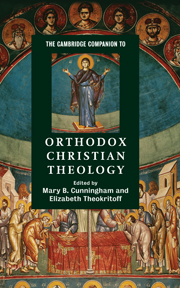Book contents
- Frontmatter
- Who are the Orthodox Christians? A historical introduction
- Part I Doctrine and Tradition
- 1 Scripture and tradition in the Church
- 2 Biblical interpretation in worship
- 3 God in Trinity
- 4 Creator and creation
- 5 The human person as image and likeness of God
- 6 Christ and salvation
- 7 Eschatology
- 8 The Church
- 9 Theology of the icon
- 10 The spiritual way
- Part II Contemporary Orthodox Theology: its Formation and Character
- Glossary
- Bibliography
- Index
- Series list
9 - Theology of the icon
from Part I - Doctrine and Tradition
Published online by Cambridge University Press: 28 March 2009
- Frontmatter
- Who are the Orthodox Christians? A historical introduction
- Part I Doctrine and Tradition
- 1 Scripture and tradition in the Church
- 2 Biblical interpretation in worship
- 3 God in Trinity
- 4 Creator and creation
- 5 The human person as image and likeness of God
- 6 Christ and salvation
- 7 Eschatology
- 8 The Church
- 9 Theology of the icon
- 10 The spiritual way
- Part II Contemporary Orthodox Theology: its Formation and Character
- Glossary
- Bibliography
- Index
- Series list
Summary
WHAT IS AN ICON?
The Greek word eikon simply means 'image', but the word has come in Orthodox tradition to mean much more than simply a pictorial representation of a religious subject. Every icon, whether it depicts Christ, the Word and Son of God, Mary the Mother of God, a saint, or a biblical scene or feast, represents a confession of faith and a witness to the Incarnation. This is because the icon is a symbol, which manifests something greater than its physical limits allow. Like the written word, an icon expresses divine truth in a manner that humans can perceive and understand. As St John of Damascus asserted in the eighth century, when Orthodox Christians 'venerate images, it is not veneration offered to matter, but to those who are portrayed through matter in the images'.
An 'icon' usually means a portable wooden panel, painted either with encaustic wax (especially before about the seventh century) or with egg tempera. However, the term refers in its widest sense also to the images portrayed in frescoes or mosaics on church walls, on sacerdotal vestments, altar vessels, Gospel and liturgical book covers, crosses and other media. Panel icons may be made not only on wood, but also on ivory, metal, textile and many other materials. Icons may serve decorative or pedagogic purposes, in addition to acting as liturgical or devotional objects. All of these forms of icons, however, share one important characteristic: they offer a window into eternal meaning and are thus worthy of honour and devotion. Such honour is not offered to the icon itself, but to what it represents.
- Type
- Chapter
- Information
- The Cambridge Companion to Orthodox Christian Theology , pp. 136 - 149Publisher: Cambridge University PressPrint publication year: 2008
- 3
- Cited by



